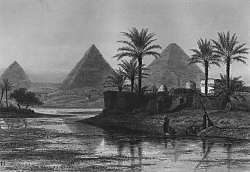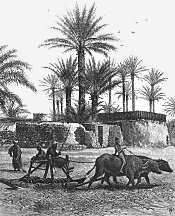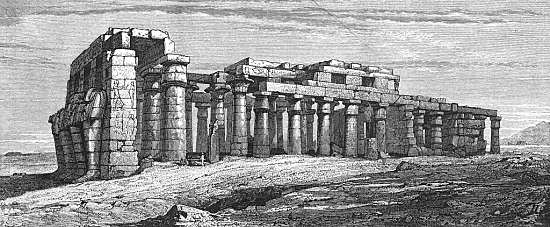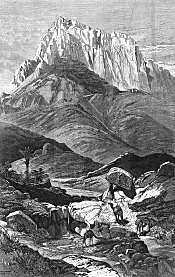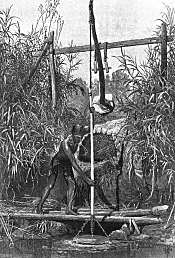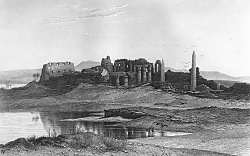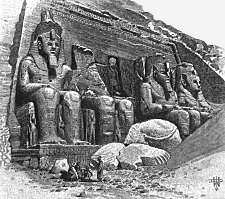
Picturesque Palestine IV: Sinai and Egypt
Of many works published by explorers of Palestine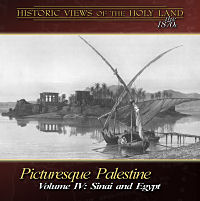 in the 19th century,
none is as highly regarded as the lavishly illustrated and expertly
written Picturesque Palestine, Sinai and Egypt. Edited by Charles
Wilson and published in four volumes in 1881, this work captures the essence of the
biblical lands in word and drawing, showing both ancient sites and
native customs.
in the 19th century,
none is as highly regarded as the lavishly illustrated and expertly
written Picturesque Palestine, Sinai and Egypt. Edited by Charles
Wilson and published in four volumes in 1881, this work captures the essence of the
biblical lands in word and drawing, showing both ancient sites and
native customs.
The descriptions of the regions were written by experts with an eye to presenting the land to those who would never have the opportunity to visit. This first-ever electronic edition includes the entirety of the original Volume 4, including 10 steel engravings, 140 wood engravings and 234 pages of text. Volume 4 includes these sections:
Sinai
by C. Pickering Clarke
The Land of Goshen
by Stanley Lane-Poole
Cairo
by Stanley Lane-Poole
Memphis
by Stanley Lane-Poole
Thebes
by Stanley Lane-Poole
Edfû and Philæ
by Stanley Lane-Poole
Complete Book: The entire book is included in a PDF file, as originally published. This is
the essence (and most difficult to reproduce) of this project and is most recommended. The original
publication is preserved exactly, with the original layout and pagination.
Thus any references to this work in other sources can be found on the same
page as in the original. In addition, the PDF file provides the
user with the ability to search, copy text into other files, and print in
high-resolution.
The first 7 pages of the Sinai section are available here in either high resolution (as in volume; 2.2 MB) or low resolution (190 kb - faster download; not as high print quality).
PowerPoint Files: For ease of use, all of the illustrations are included in PowerPoint format. This makes it easy for the user to quickly copy and paste slides into their own PowerPoint presentations. For easy identification, each illustration includes the original caption in the "Speaker's Notes" section of the slide.
The Images: All images are high-resolution (1600 x 1200 or higher) jpeg files, ideal for projecting in a classroom, viewing on a monitor or printing. Click on one of the images below to see a medium-resolution version.
Price: $20; or get all 4 volumes for $75; now
$55
Guarantee: you will be satisfied or your money will be refunded.
Table of Contents
SINAI. By the Rev. C. PICKERING CLARKE
Suez.—The Canal.—“Passage of the Israelites through the Red Sea.”—Zoan.—Wells of Moses.-Arab Life.—The Desert.—Marah.—Peculiarities of the Sinai District.—Rain Storms.—Elim.—Pharaoh’s Bath.—Traditions relating to Moses and Pharaoh.—Wâdy Taiyebeh.— Inscriptions in Wâdy Mukatteb.—Ruins of Sarâbít el Khâdim.—Turquoise Mines.—The “Wild Roe.”—Tamarisks.—Manna.—Stories about the Bedawín.—March of the Israelites.— “Encampment of the Red Sea.”—The Plain of El Markha.—Wâdy Sidreh.—Egyptian Tablets in Wâdy Maghârah.—Nomenclature of Mountains and Valleys.—Wâdy Feirân.—Horeb.—The Stricken Rock.—The Battle at Rephidim.—The Amalekites.—Jebel Tâhúneh.—Ancient Weapons.—Groves of Tamarisk.—“The Girls’ Mount.”—Pharan.—Nâwâmis.—“Mount of the Conference.”—Mount Serbâl.—The “Lighthouse.”—Monasticism.—St. Anthony.—Paul the Hermit.—Wâdy Sigillíyeh.—Port Royal.—“Mount Sinai” Traditions.—Inscriptions.—The Empress Helena.—Jebel Músa.—Nebí Sâleh.—The Thamudites.—The “Mountain of the Law.”—The Wilderness of Sinai.—Difficulties of Travelling.—Jethro’s Visit to Moses.— Elijah.—“The Mount of God.”—Public Worship.—Springs.—“The Speaking Stone.”— Streams and Fruit-gardens.—Nagb Hawa, “The Pass of the Wind.”—Jebel Músa.—Jethro’s Valley.—Aaron’s Hill.—Convent of St. Catherine.—The Convent Garden.—Holy Places on Jebel Músa.—Great Plain of Er Rahah.—“Moses’ Cleft.”—Convent of the Forty Martyrs.— Convent of the Twelve Apostles.—Wâdy Lejâ.—Jebel Katarína.
THE LAND OF GOSHEN. By STANLEY LANE-POOLE
Wall-painting at Beny Hasan.—The Suez Canal.—The “Field of Zoan.”—The Hyksos, or Shepherd Kings.—Rameses II. (Pharaoh the Oppressor) at Zoan.—Description of the City by a Contemporary Poet.—Excavations at Tell-el-Maskhûtah, the site of Pithom-Succoth.—Store - chambers built “unto Pharaoh” by the Children of Israel.—Brick-making, Ancient and Modern.—Sesostris at Zoan.—Overthrow of the Cities of the Delta.—Site of the City of Goshen at Fakûs, the Greek Phacussa.—Site of Heliopolis, or On.—The Solitary Obelisk.— The Temple of On.—Mounds and Ruins.—The Virgin’s Tree.
CAIRO. By STANLEY LANE-POOLE
Narrow Lanes and Winding Alleys.—The “Thousand and One Nights.”—Origin of the Capital of Egypt.—History of its Growth.—Walls and Gates of Cairo.—Modern “Improvements.”—The Old Fâtimy Quarter.—Street Scenes.—Private Houses.—Lattice Windows.—Shops.— Bazaars.—Mosques.—The Memlûks.—En-Nâsir.—Mâristân of Kalaûn.—Mosque of Sultan Hasan.—“Tombs of the Khalifs.”—Tomb-mosque of Kaït Bay.—Construction of Mosques.— Schools and Street Fountains.—The Citadel.—Mosque of Mohammad Aly.—View from the Citadel.—The Old Suburb, El-Katâï.—Mosque of Ibu Tûlûn.—El-Khalîg, or “the Canal.”— Gardens on the Canal.—Arabic Verses, translated by the late Professor Palmer.—Masr El- ’Atîkah.—Island of Rodah.—The Nilometer.—Proclamation of the Rising of the Nile.— Ancient and Modern Customs attending the Ceremony of Cutting the Dam of the Canal.— Curious Letter addressed by ’Omar, Prince of the Faithful, to the Nile of Egypt.—Fustât.—The Mosque of ’Amr.
MEMPHIS. By STANLEY LANE-POOLE
The Builders of the Pyramids.—Bûlâk.—Menes.—The City of Memphis.—Abd-el-Latîf’s Description of its Ruins.—The Pyramids of Gîzeh.—The Red Pyramid.—The Tomb of Queen Nitocris.—“The Lady of the Pyramid.”—The Sphinx.—Construction and Object of the Pyramids.—Pyramid of Steps.—Pyramid of Meydûm.—Rahotep and Nefert.—Pictorial Records preserved in Tombs at Memphis and Sakkarah.—The Serapeum.—The gigantic Cemetery of Sacred Bulls.—M. Mariette’s Discoveries.—Manfalût.—Cemetery of the Sacred Villages and Towns on the Nile.— Minyeh, its busy Bazaars and Market-place.—Asyût or Siout.—Pottery.—Ancient Tombs.— Girgeh.—Ruins of Abydos.—Burial-place of Osiris.—Plan of Egyptian Temples.—Wallchiselling at Abydos.—Kom-es-Sultan.—The Story of the Risen Osiris.—Denderah.—Portraits of Cleopatra.
THEBES. By STANLEY LANE-POOLE
The Plain of Thebes.—The “Valley of the Kings.”—Temple of Deyr El-Bahry.—Queen Hatasu’s Obelisk at Karnak, the tallest in Egypt.—“City of Amon.”—Thebes.—Wall-pictures, Medînet Habû.—Rock-cut Tombs in the “Valley of the Kings.”—Memorial Chapels in the Plain.— Temple of Kurnah.—Tomb of Seti I.—The Ramesêum.—The shattered Colossus of Rameses.—The Twin Colossi of the Amenopheûm.—The Vocal Memnon.—Temple of Rameses III., or Medînet Habû.—The Theban Triad.—Characteristics of an Egyptian Temple.—Temple of Luxor.—Causeway from the Great Pylon of Luxor to Karnak.—Temple of Khons.—Temple of Mout.—Great Temple of Amen-Ra.—“Hall of Columns.”—Obelisk of Queen Hatasu.—Wall-pictures at Karnak.
EDFÛ AND PHILÆ. By STANLEY LANE-POOLE
The Nile above Thebes.—Erment.—Esné.—Temple of Horus at Edfû.—Sculptured Walls and Inscriptions.—The Gorge of Gebel-es-Silsileh.—Kom-Ombo.—Island of Elephantinê.— Aswân.—Its Bazaar.—The First Cataract.—Philæ.—Temple of Isis.—The “Holy Island.”— Burial-place of Osiris.
The Ramesseum
